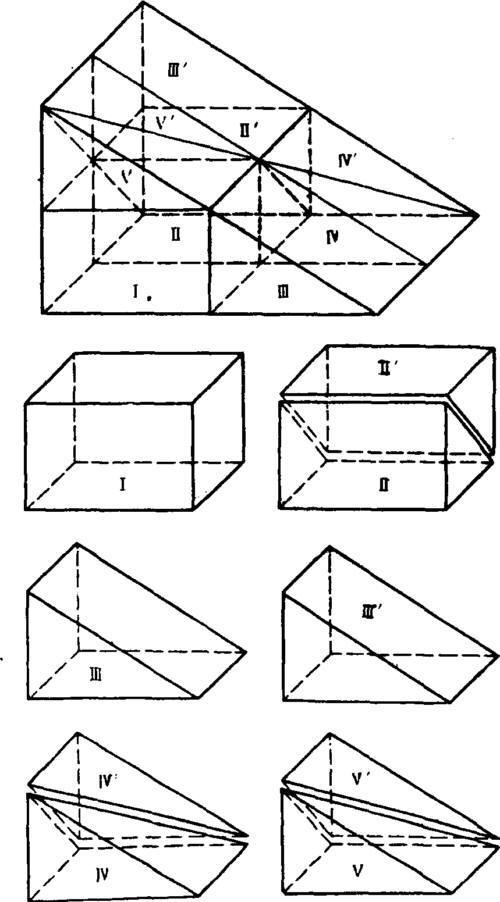Chapter 50 Section 4 Liu Hui Principle
Regarding the Yangma volume formula V=(1/3)ahb and the soft-shelled turtle volume formula V=(1/6)ahb proposed in "Nine Chapters", Liu Hui used the experimental method to prove the case of a=b=h of.However, in the case of a≠b≠h, the three yang horses divided into one cuboid are not congruent, and the six turtles are not congruent or symmetrical. Whether the volumes of the three yang horses are equal, and whether the volumes of the six turtles are equal Equality is not obvious, and empirical methods are powerless.So Liu Hui said: "The soft-shelled turtle has a different shape, and the yang horse has a different body. However, if the yang horse has a different body, it cannot be purely combined, and if it is not purely combined, it is difficult to do it." ("Nine Chapters Shang Gong Zhang Notes") He found another way, The proofs of these two formulas are successfully completed by infinitesimal division.To this end, he first proposed a principle:
Evil solutions to blockages, one of which is Yangma, and the other is softshell turtle.The Yang horse occupies the second place, and the soft-shelled turtle occupies the first place, which is not easy.
That is to say, in a blockage, there is always V:V=2:1
Wu Wenjun called it Liu Hui's principle.Obviously, as long as this principle is proved, the above two formulas are self-evident from the volume formula of the cutoff.The problem boils down to proving Liu Hui's principle.
Liu Hui used three mutually perpendicular planes to divide the length, width, and height of the block equally, and the Yang horse in it was divided into a small cube I, two small cut blocks II, III, and two small Yang horses IV, V. Divided into two small barriers II', III' and two small turtles IV', V'.They can be put together into four congruent Ⅱ-Ⅱ', Ⅲ-Ⅲ', Ⅳ-Ⅳ', Ⅴ-Ⅴ' and small cube I. (See Figure 38) Obviously, in the first three small cubes, that is, in the 3/4 of the cutting block, the ratio of the volume belonging to Yangma to that belonging to Turtle is 2:1.The ratio of the two volumes in the fourth small cube is unknown, but the composition of its two small blockages is completely similar to that of the original blockage, and its length, width, and height are half of the original blockage.Repeat the above-mentioned division and combination for these two small barriers, that is, "put half of the remaining width, length, and height, and then three-quarters can be known." If this continues, "half is less, and the rest is less." It is fine, and the smallest is micro, and the micro is invisible. From this point of view, what is safe?" Thus, Liu Hui's principle was proved in the whole barrier.The limit process is very obvious.

Figure 38 Proof of Liu Hui's Principle
The proof of Liu Hui's principle and the volume formulas of Yangma and Turtle are the core of Liu Hui's volume theory.For other polyhedrons, Liu Hui decomposed them into a finite number of cuboids, moats, yang horses, and turtles, and calculated the sum of their volumes to solve it, thus establishing his volume theory on the basis of infinitesimal division. Gauss, a master of mathematics in the 19th century, once proposed the conjecture whether it is impossible to solve the volume of tetrahedron without the help of infinitesimal division.This conjecture later became the basis of the third problem in Hilbert's "Mathematical Problems", and was solved affirmatively by Hilbert's student Dern.In fact, Liu Hui began to think about this problem as early as 1600 years before them.

Figure 38 Proof of Liu Hui's Principle
